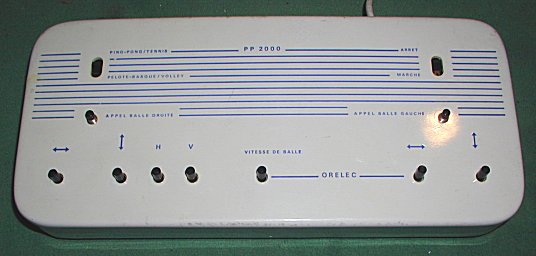-
1976
Hardware Description
This system, model PP-2000, was released in 1976 by a French company called ORELEC. It is unknown if the company still exists, but one web page shows an ORELEC company created in 1974, which designed electronic devices sold in small quantities.
The PP-2000 system uses two potentiometers to adjust the video rates (vertical and horizontal holds) and another two per player for vertical and horizontal paddle motion. A last one adjusts the ball speed. Two push-buttons are also used to serve the ball. The system plays two games: Tennis (Ping-Pong) and Pelote. The circuit board contains 11 TTL integrated circuits, all of which are simple logic gates: three MM-7400 (same as 7400), and eight MM-7402 (same as 7402). The chips in the pictured specimen are made by National Semiconductor.
The games are very similar. The only two differences between them are the presence of the central dashed line and the shape of the second player. The game switch hides the central dashed line, and inverts the second player, which becomes a vertical line with a hole at the place of the paddle. The pictures below show pretty well what happens. It is interesting to note how analog circuits hide the central line: it is almost black but still visible.
The interesting feature of this system is the use of the H and V potentiometers, which adjust the horizontal and vertical frequencies of the video signal. H sets the horizontal frequency and most television sets of that time would tolerate both American and European horizontal frenquencies. However, the V potentiometer adjusts the vertical hold (frame rate), which was the source of incompatibility between foreign television sets (for example, an American television set designed to work with the 60Hz frame rate would not always tolerate the European 50Hz frame rate). The V potentiometer solved that problem, making the Orelec PP-2000 usable worldwide.
A last word about this system: if the PP-2000 plays only two games, other variants can be easily created in Pelote mode:
- Squash can be played by turning the vertical motion potentiometer of the second player to its maximum or minimum position. This will hide the hole and leave a vertical bar used as squash wall.
- Basketball is played by placing the hole of the second player on the uppest visible position.
- Mouse is played by placing the hole of the second player in the lowest visible position so as to form a mouse hole where the ball (the mouse) should go.
The above game variants can even be made more difficult by asking somebody to control the horizontal position of the second player so as to simulate a moving wall. Acting on the ball speed would bring more challenge as well !
It is important to note that such basic systems often proposed a number of games based around only two or three game types. Advertising the PP-2000 as playing five games would have been typical in 1976.
-
Model Number:
PP-2000 -
Manufacturer:
-
Hardware Type:
Video Game -
Manufacture Year:
1976 -
More Info:
-
We recognize our sponsors starting at $1 per entry.
Learn more at https://www.ithistory.org/benefits

